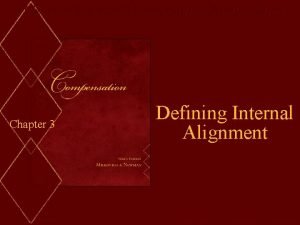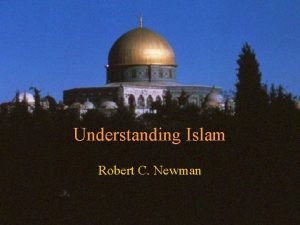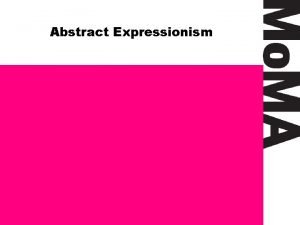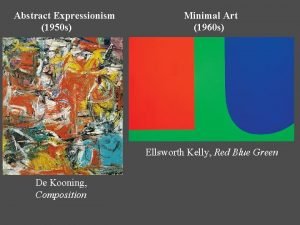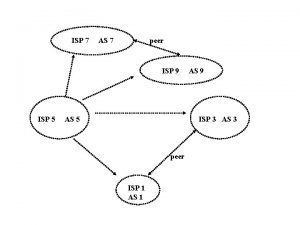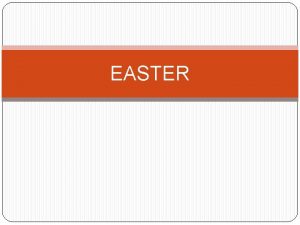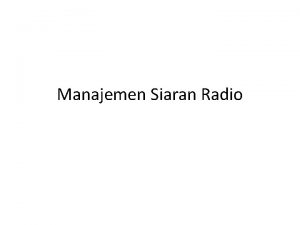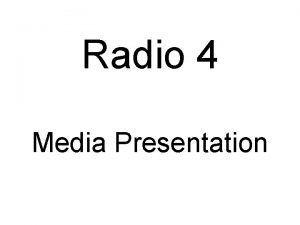Media Easter ISP Radio Georgia Newman Task 4



























- Slides: 27

Media Easter ISP: Radio Georgia Newman Task 4 & 5

What is a radio public service broadcaster? A radio or television broadcaster that is seen to offer a public service by catering for a range of tastes and audiences. The main public service broadcasters in the UK are the BBC, ITV, Channel 4, Channel 5 and S 4 C

What are the 5 categories of commercial radio stations in the UK? Give examples There are over 300 commercial radio stations in the UK. These are: - National commercial radio: there are three of these stations broadcasting at the time if writing: Classic FM, Talksport and Absolute Radio - National Brands: these are regional stations that have been collected into networks, sharing some programmes and syndicated output. They are; Global radio (Heart, Galaxy, Gold and Radio X), Bauer Media Group (Kiss and Magic), Guardian Media Group (Real Radio) - Independent local radio: these are regional commercial stations. They are specific to a certain area of the country and are not part of a network group - Community radio: this is a different format from public service and commercial stations. Community stations serve their local areas and produce content of interest to local people. The stations are non-profit making and are usually funded by the local community - Hospital Radio: there are hundreds of these radio stations based in hospitals and staffed by volunteers, broadcasting in the UK, Many radio presenters started out in hospital or community radio.

Marketing: How does the BBC promote its stations and programmes? • Cross-platform marketing: other radio stations and BBC television will promote radio stations and events related to BBC radio, for example ‘T in the Park’ • Billboard and magazine advertisements for stations and presenters • Each station has its own website within the umbrella website for BBC radio. These allow listeners to access live audio streaming and to listen to archive programmes. They also provide interactive opportunities for an audience and can be accessed by a global audience • BBC radio produces promotional films focusing on a particular part of its output, for example its presenters or news coverage • BBC Taster is an interactive service that enables the BBC to showcase experimental ideas and new talent. It allows audiences to give feedback on what they see and hear. It is also a space for the BBC to develop content and emerging technology

What are the seven codes and conventions of speech-based radio programmes? • A presenter: although this is can also be the case for music-led formats, the presenter in speech-led programmes acts as an anchor to guide the discussion between various guests, for example, Lauren Laverne in LNWH, or as a judge in a quiz programme, for example Miles Jupp in The News Quiz on Radio 4 • Discussions: a group of people discussing a range of topics. This sub-genre of programme is often a key part of Radio 4’s schedule. LNWH uses this style, with each programme centring on a key topic. • Phone-ins: these are effective, cheap ways of involving the listeners, who are encouraged to take part in the programme and offer their point of view. For example, Jeremy Vine’s lunchtime programme on Radio 2 • Contributors: new magazine programmes such as Today and PM on Radio 4 invite guests who tend to be experts or knowledgeable in the topic under discussion. The 8. 10 am slot on the Today programme is renowned for being reserved for eminent contributors such as, for example, the Prime Minister. LNWH has highbrow female guests including writers, artists and academics • Drama: Radio 4 has a regular feature of The Afternoon Play. Other dramas include the long-running radio soap The Archers • Documentaries: these may be related to news items or current affairs, or be music themed, for example the life of a particular pop start or musician • Outside broadcasts: reporters, presenters and mobile studios bring stories and features from different national and global locations. The flexibility of the radio medium means that it does not have to rely on visual images and therefore the reports can be more immediate. The focus is on the human voice and sound effects.

What is scheduling and how does it work in the BBC’s radio programming? Just like television, each radio station has a schedule and programmes are stripped across the schedule. The regular programmes for each station are broadcast at the same time each day. The scheduling of a particular programme would have been researched in order to maximise the target audience. This is still the case even though, with advances in digital technology, listeners can catch up on radio programmes through ‘Listen Again’ and podcasts. The radio, more so than TV, divides up its day related to what the audience may be doing. Radios 1 and 2 both have breakfast shows, which bring in a large section of audience who are getting ready for, or travelling to, work. These are largely music-led but also incorporate chat, sport, traffic and regular slots specific to the programme. These regular features build up expectations in the audience and gives a structure to the programme. Similarly, a speech-led station such as Radio 4 engages in stripping as part of its schedule. For example, Woman’s Hour and its spin-off LNWH, both have specific scheduling times. Woman’s Hour is broadcast every day at 10 am. However, the scheduling for LNWH is more interesting, it is a monthly programme broadcast, as the name would suggest, at 11 pm. The assumption is that a lot of listeners will choose to listen via the podcast, but keeping it in the schedule at this time allows the programme to include more adult content.

Who is the voice of Late Night Women’s Hour (LNWH) on Radio 4? It is presented by Lauren Laverne who is a similar age to the target audience and is known for her involvement in music and the arts. She is a presenter on Radio 6 Music and fronted The Culture Show, as well as covering Glastonbury for the BBC.

Who Regulates the Radio and Television Broadcasting Industry? The Communications Act of 2003 established Ofcom as the new UK regulator. Previously, the role had been held by a range of different regulatory bodies. The BBC as a public service broadcaster was regulated by the BBC Trust and Ofcom until 2017, but is now solely regulated by Ofcom. Accountable to parliament, Ofcom is involved in advising and setting some of the more technical aspects of regulation, implementing and enforcing the law. Ofcom is funded by fees from industry for regulating broadcasting and communications networks, and grant-in-aid from the government. Like TV, BBC radio has public service remit to inform, educate and entertain, which is evident in its range of stations catering for diverse audiences and interests, including the classical output of Radio 3, Radio 1 Xtra, which plays contemporary hip hop and Rn. B aimed at 15 -24 year-olds, and the BBC Asian Network to cater for the British Asian community. Commercial and community radio stations have to apply for their licenses from Ofcom, and have to abide by their rules and regulations regarding output.

What is the role of this regulator? - To ensure that a wide range of TV and radio services of high quality and wide appeal is available - To maintain plurality in the provision of broadcasting - To adequately protect audiences against offensive or harmful material - To protect audiences against unfairness or infringement of privacy - When Ofcom receives a complaint, it assesses it under the terms of the Broadcasting Code and decides what action to take.

Key Theory: How can Curran and Seaton’s Power and Media Industries be applied to the BBC and LNWH? Curran and Seaton argue that the media is controlled by a small number of companies primarily driven by the logic and power, and how media concentration generally limits creativity and variety. While the BBC radio stations certainly show variety in content, appealing to many different audiences, you could argue that as a major deliverer or radio and TV programmes, ranging across many stations is an example of media concentration which despite variety could be inhibit creativity, because the BBC is just one company and a business which is looking for profit. LNWH is also an example of media concentration, a it’s a spin off of Women’s Hour, making a spin-off instead of a brand new show is an example of media concentration limiting variety.

What are the 4 factors that create appeal for Radio audiences? - The blind medium: it only involves the sense of hearing with no visual images. In this sense the medium can be seen to have advantages in that it allows the audience to use their imagination - The companion medium: the radio format provides a strong sense of personal communication for the audience. It also offers interactive opportunities – audiences can text and email programmes and get a ‘mention’ or a ‘shout out’ on it. Some programmes have phone-ins where listeners can air their views or select music to be played - The intimate medium: radio is very personal. It encourages intimacy by the use of the direct mode of address - The undemanding medium: it allows the audience to do other things while listening. A criticism of TV in the early days was that it didn’t ‘go around the corners’; with radio, a listener does not need to devote their time entirely to the platform

How does LNWH appeal to audiences? - The choice of the presenter. Lauren Laverne is of a similar age group to the target audience. Her Northern accent also subverts the stereotype of the typical Radio 4 presenter and makes her more relatable to the audience - The language and mode of address are aimed at a younger female target demographic - It appeals to a niche, specialised audience signified by the scheduling time - The themes of the programme and subsequent podcasts are constructed to be one of interest to the specialised audience - The audience is constructed through the style of the programme and the choice of guests – guests tend to be educated and often highbrow, for example Susie Orbach, a psychotherapist and author, and Rachel Hurley, a research fellow at Cardiff University - It is available across a range of platforms and is therefore available to a global audience

How can you apply Stuart Hall’s Reception Theory to LNWH? Hall asserted that communication is a process involving encoding by producers and decoding by audiences. He said that there are three ways in which messages and meanings may be decoded by audiences. 1) The dominant position: the audience accepts the intended meaning encoding, 2) The negotiated position: the audience acknowledges some of the messages encoded by the producers of the product but may question or adapt the message to be more relatable to their own experiences, 3) The oppositional position, the encoder’s message is understood, but the decoder disagrees with it. In terms on LNWM, maybe the preferred position is to see it as feminist, and reflective of social change, and the oppositional response is to see it as exploitation of social change to get more audiences. (Answer from back of book: it could be assumed that as the listener has tuned into or downloaded the program they are part of the target audience and will therefore accept the preferred reading of the text. However, some audiences may adopt a negotiated response because they do not agree with some of themes that are covered by the programme).

What is the social and cultural context of LNWH? The introduction of LNWH into the Radio 4 schedule demonstrates the BBC’s awareness of the need to cater for all areas of society. The topics discussed in the programmes reflect what is of interest and concern to young women in society today and cater for a specific social group who have been previously under-represented.

Task 5: Booklet Notes

Product Context - Late Night Woman’s Hour is a spin-off from the long-running BBC Radio 4 daily magazine programme, Woman’s Hour. - Late Night Woman’s Hour is broadcast once a month, late at night, is presented by Lauren Laverne and features a number of female panellists. - Each episode focuses on a particular theme relevant to its female audience e. g. ‘home’ and ‘forgiveness’. - It began broadcasting in 2015

Historical Context The original Woman’s Hour first broadcast in the 1940 s – this could be seen as a minority audience programme – one hour a day or week set aside just for a female audience. This might further suggest that all other programming on BBC Radio was aimed at a male audience. Further, this might suggest a strong sense of patriarchal control, both on the BBC and in UK society at the time Late Night Women’s Hour features frank and open discussion, and demonstrates a shift in society and increased gender equality although some of the issues raised reflect the fact that society is not yet completely equal.

Institution and Economics The BBC raises its finances from the license fee – currently at £ 147 per year – and is paid by the UK population in order to consume TV and radio broadcasts, whether they are BBC products or not. Since 1922 the BBC has been committed to its mission to inform, educate and entertain Late Night Woman’s Hour could be seen as a typical example of Public Service Broadcasting (PSB) and therefore of the BBC, due to its ‘niche’ audience. It could be argued that commercial broadcasters (those who are set up to make a financial profit through advertising) might see a programme like LNWH as being too specialised, aimed at a relatively small audience and broadcast at an unpopular time. Purely commercial institutions would be less likely to produce a product like this due to the relatively low audience figures, lack of sponsorship or advertising deals to tie-in with the programme, and its specialist nature. The programmes have only female contributors, is made up predominantly of just dialogue (without music, sound effects etc. ) and the topics explored use intellectual and specialised vocabulary. The BBC, however, have a commitment to producing a wide selection of content, aimed at all sections of the population. In which case, LNWH could be seen as a ‘typical’ BBC product.

Technological change and media production, distribution and circulation and the impact of digitally convergent media platforms Scheduling - Late Night Woman’s Hour has an 11 p. m. broadcast timeslot. However, audiences can now listen on digital devices other than radios and download podcasts to enjoy at their leisure which means the time a broadcast airs live might be less significant. Digital technology, such as Digital Audio Broadcasting (DAB), possibly offers broadcasters like the BBC more freedom to produce challenging content which would normally got out after the 21. 00 watershed (the time which more ‘adult’ themes can be shown on TV and radio, such as violence or language), and still be heard at any given time though downloadable content.

Theoretical approaches - Power and media industries (Curran and Seaton) It could be argued that programmes like LNWH, and the general product output from the BBC, challenges the idea that the media is run purely for economic profit and power, while being controlled by a small number of powerful companies, such as Sky, News Corporation and Disney, for example. Late Night Woman’s Hour might also be used to support Curran and Seaton’s idea that socially diverse patterns of ownership help create conditions for varied and adventurous productions, In other words, the more variation of media companies which exist leads to greater choice and potential risks to be taken with product. It could be argued that the success and growth of podcasts across a range of topics and genres could also be due to the relative inexpensive production costs and hosting facilities on a range of divergent technologies. Podcasts are also available to a wider global audience, which widens the target market.

Social and Cultural Contexts A few questions to consider might be: How has the role of women changed in the last 70 years since the original Woman’s Hour first broadcast? (You could think back to the representation of the housewife in the Tide advert and the representation of Aveline in Assassin’s Creed 3: Liberation as indication of some sense of change) How different is life in the UK for women now? How social and cultural circumstances now allow for an audience for a late night talk show aimed at women?

How audiences are grouped and categorised by media industries, including by age, gender and social class, as well as by lifestyle and taste The audience for Radio 4 generally can be categorised in terms of age, social class and expected levels of education. This referred to as Demographics. Alternatively, Psychographics is the method of categorising audiences by their lifestyle, values, attitudes and tastes. Consider how Radio 4 - and Late Night Women’s Hour in particular - might benefit from a Psychographic approach. A stereotypical Radio 4 listener is likely to be educated often to degree level, be in a managerial/senior/educational job environment, upper-middle class, aware of current affairs – and most likely male Consideration should be given to how Late Night Woman’s Hour challenges the established audience of this channel. Some examples of these challenges to the Radio 4 audience might include the obvious gender bias (the clue is in the title), the presence of Lauren Laverne as the main presenter and the nature of the content. Lauren Laverne should be considered in view of her background – she was once a member of an indie-rock band, Kenickie, in the 1990 s. This would make her an untypical ‘Radio 4 -type; presenter.

How audiences interpret the media and how and why audiences may interpret the same media in different ways We might consider a male response to the content of the show and with its exclusive panel of female guests, how this might be unsettling or alienating for male listeners. The nature of the programmes are not solely female-targeted material, but quite often it does take an exclusive female ‘take’ on the subjects. We might also recognise the ways in which the broadcast has been designed to invite audience members to enter the discussion through social media platforms – Twitter being the most popular form of response. Might the controversial nature of some of the episodes have been designed to invite strong responses and divide audience opinion?

Audience targeting for Late Night Woman’s Hour Highlights the nature of PSB and the BBC’s mission of inform, educate and entertain. Designed to explicitly appeal to a specialised (educated, female) audience, with potentially a younger age group than usual for Radio 4. This might be due to the content of the programmes and the makeup of the guests. Is its apparent success down to its uniqueness, as this is the only programme of its type on radio? ITVs Loose Women could be somewhat compared for television, but the target audience is perhaps not so ‘educated’? The programme may also be targeting a younger audience (late teens to early thirties) with the variety of subjects featured in the series

Stuart Hall’s Reception Theory Consider how a negotiated or oppositional reading of the programme might be used. How would a male audience respond to an all-female broadcast, debating issues from an entirely-female perspective? (Answer from back of book: it could be assumed that as the listener has tuned into or downloaded the program they are part of the target audience and will therefore accept the preferred reading of the text. However, some audiences may adopt a negotiated response because they do not agree with some of themes that are covered by the programme).

Feminist Theory A broad term which could also cover aspects of society and culture. Radio for women about women by women The series provides women with a vehicle through which to discuss and construct representations of gender The set product programme – ‘Home’ – sets up a diverse and challenging discussion on the subject and the changing place of women within that environment

Key Terms Mentioned AUDIENCE – target, global, positioning, categorising, profile Reception Analysis PUBLIC SERVICE BROADCASTING COMMERCIAL BROADCASTING THE BBC’S MISSION – inform, educate, and entertain NICHE MARKET DIGITAL CONVERGENT PLATFORMS IDEOLOGY – linked to representation and of the BBC SOCIAL MEDIA PLATFORMS DEMOGRAPHICS – link to Audience PSYCHOGRAPHICS – link to Audience
 Local isp vs regional isp
Local isp vs regional isp Each easter eddie eats
Each easter eddie eats Awin radio
Awin radio Tiered task bias task
Tiered task bias task Dash vs wedge
Dash vs wedge Frederick taylor teoria
Frederick taylor teoria Newman projection practice
Newman projection practice What shapes internal structure
What shapes internal structure Margaret newman theory in practice
Margaret newman theory in practice Plymouth uni accommodation portal
Plymouth uni accommodation portal Ecosystems at risk hsc notes
Ecosystems at risk hsc notes Newman projection of cyclohexane
Newman projection of cyclohexane Cardinal newman college timetable
Cardinal newman college timetable Is deciding
Is deciding Gerald levey and mark newman
Gerald levey and mark newman Newman projection generator
Newman projection generator Barnett newman abraham
Barnett newman abraham Robert c newman ii
Robert c newman ii Bisturí kirkland y orban
Bisturí kirkland y orban Butano newman
Butano newman Gerald levey and mark newman
Gerald levey and mark newman Gerald levey and mark newman
Gerald levey and mark newman Proyeccion de newman del propano
Proyeccion de newman del propano Carrot dude
Carrot dude Plastic bag theme american beauty
Plastic bag theme american beauty Barnett newman vir heroicus sublimis
Barnett newman vir heroicus sublimis Joseph kosuth: one and three chair barnett newman
Joseph kosuth: one and three chair barnett newman Newman college
Newman college







